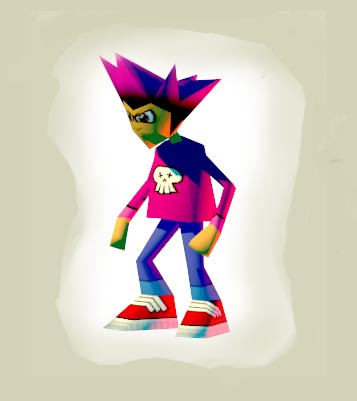One of the most fun and difficult things when doing the graphics for a 3D game, is doing the low polygon characters. Creating the highpolygon backgrounds or movies isn't half as difficult as doing a characteristic games figure in around 200 polygons and isn't even close of being as challenging.
[size="5"]Modelling:
Before I start modelling, I quickly do a pencil sketch of the character I want to design. Preferably from two or three angles. Front and Left view as well as something similar to a "user view" angle. Doing this I get an overview of the character, and I can easily see which standard primitives that are going to be the "base" of the model. The initial modelling can be done in many different ways. Sometimes I start by making an advanced nurbs model which I then optimize, and sometimes I simply draw a box or cylinder and extrude some bits here and there. I must confess that the latter is my most used method. Generally, I build the torso, legs, arms and head one at a time. A hint at this point would be to make clear how the model is going to be projected in the game. If you have a horizontally scrolling game, there is no point in doing, let's say an arm, using a box. Simply use one face which always is turned to the camera. And also note that there is rarely any need for making an arm using a box. Use a cylinder with three sides. That is plenty enough most of the time. Also make sure that the faces at the ends of the cylinder are removed. However, also check if your 3D engine has support for 2 sided materials or strange effects could occur. Also think about the materials. You can cheat so much using materials. Opacity maps are your friends...and use them. The amount of polys you can save there is enormous! Instead of modelling eyes, simply add one face in the eye-area, and put an opacity map there... You can also make the eye blink simply by scaling the face. You can also make a pretty jagged model look smooth, both by using smoothing in the graphics package you're using, but also shade the actual material. Don't get too hot on the textures though, most 3D engines don't like maps bigger than 64x64 pixels. Maps are very memory consuming, which is also why it is very seldom you get to use an animated material.
[size="5"]What package to use:
When creating low polygon models, I prefer working in the good old 3D Studio 4 package. I feel I have complete control over the faces in there, which is absolutely necessary when optimizing the mesh. I also think that the optimizer plugin for 3DS4 is somewhat better than the one for 3DSMax, but that might just be a matter of taste. The initial work is sometimes done in 3D Studio Max, though. It is always nice to get a good shaded view of the object you're working on, but when it comes to the actual optimizing, I feel 3DS is superior in every sense. The material handling and mapping is of course superior in 3D Studio Max. It is almost impossible to do good mapping in 3D Studio 4.
I have not tried Lightwave myself, but many of my friends use it, and they all say that working with lowpoly models in Lightwave is very easy to do. I wouldn't want to animate using Lightwave though.
[size="5"]Animating:
With our current 3D engine, all the animations have to be done in 3DS4 using simple keyframes. This is of course very nice for me, coming from the old scene where all animations had to be pixeled frame by frame. When animating low polygon characters, I prefer working in 3DS4 before Max. 3DS4 is very simple to animate in, and the "Trackinfo" doesn't have any other functions than setting position, rotation, scaling, morphkey and hide-information. This is just what you need to make simple animations. I have personally not found any major use for Inverse Kinematics when working with these simple meshes. That is more useful when working with a higher polygon count. Animating a low polygon character is pretty different from 3D engine to 3D engine. As I mentioned earlier in this paragraph, we use keyframe data. Many other engines use "snapshots". Snapshots could be easier to work with as you can use the art package's different plugins and animating tools, but snapshots steal a lot of memory, which is why we decided not to use that. In 3D Studio 4 you can also save animation information to an ASCII format called .VUE. This is also good, but can steal a lot of processor time. We found that reading the .3DS or .PRJ format and use that "as is" was the easiest and most efficient way of using the animations created.
When it comes to the actual games character animation, it is very similar to any other forms of animating but with one small difference. You have to exaggerate! All steps and bodyturns have to be extreme. That is for two reasons mainly. One, the character is often so small that it would be impossible to see the subtle movements... and two - it is always much more fun!! Looking at other artists animations, I see that the biggest mistake some of them do when animating, is not thinking about the weight of the character (organic or nonorganic) and its secondary animations. The result is that it looks weightless...like it "floats" when walking. It is always better to exaggerate. That is the clue to making a good and fun games character. After all, it is fantasy worlds we are making when we are developing a game, not a documentary... we get a bit too much out of real life every day...
Written by: Niklas Malmqvist, [email="niklas@gamedesign.se"]VFX Productions,
eMail[/email]
One of the most fun and difficult things when doing the graphics for a 3D game, is doing the low polygon characters.
Advertisement
Recommended Tutorials
Advertisement
Other Tutorials by Myopic Rhino
27031 views
24402 views
Advertisement




